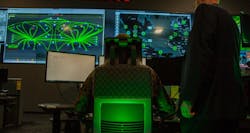Researchers ask industry for enabling technologies in artificial intelligence (AI) and machine automation
Officials of the U.S. Defense Advanced Research Projects Agency (DARPA) in Arlington, Va., issued a broad agency announcement last week (HR001121S0029) for another part of the Redefining Possible project, which places heavy reliance on artificial intelligence (AI) and machine automation.
Potential U.S. adversaries such as Russia and China have developed ways to counter today's U.S. military systems that are built around exquisite, monolithic integrated systems. Instead, DARPA researchers want to develop revolutionary system architectures that are separate, dispersed, disruptive, and that instill doubt in U.S. adversaries.
DARPA experts want to identify promising technologies and move them quickly to the next phase of research and development. Technologies should improve resilience, responsiveness, range, lethality, access, endurance, and affordability to enable new joint force warfighting concepts. Many of these technologies rely on AI and machine autonomy.
For aircraft, researchers point out that traditional stealth technologies are approaching their limits, and that potential adversaries have developed several different countermeasures to U.S. stealth aircraft technologies.
Moreover, DARPA officials say they are interested in systems to counter the proliferation of advanced integrated air defense systems (IADS), including extremely capable surface-to-air and air-to-air missiles.
DARPA also is interested in aircraft-related enabling technologies that:
-- enable next generation unmanned aerial systems;
-- use distributed, disaggregated systems to reduce reliance on small numbers of exquisite platforms;
-- enable timely delivery of targeting data and tactical targeting;
-- enable aircraft capabilities that previously have not been exploited;
-- enable levels of machine autonomy that can minimize the risk to human warfighters, and make platforms more attritable, and allow piloted and autonomous systems to operate in concert; and
-- enable development and fielding systems more rapidly, such as model-based systems engineering, multi-dimensional optimization, and additive manufacturing.
For ground systems, DARPA researchers are interested in enabling technologies that:
-- coordinate and plan in the presence of adversaries with limited knowledge of the environment, can handle battlefield surprises, and adapt to new events;
-- protect soldiers, and extend the warfighter's range;
-- amplify effects, and reconfigure to account for attrition;
-- help develop autonomous systems that operating quickly;
-- incorporate advances in machine autonomy for integrated manned and unmanned ground operations;
-- provide small units or individual warfighters with improved mobility and lethality; and
-- expand the ability for ground forces to deal with air threats, operate inside the interiors of buildings, and use natural and pre-dug subterranean environments.
For maritime systems, DARPA researchers are interested in enabling technologies that:
-- enable a dispersed system-of-systems architecture that complicates an adversary's plans by reducing warfighting reliance on monolithic, high-value surface and sub-surface assets; -- organically defeat raids of sea-skimming high-speed missiles; -- counter advanced submarines, sea mines, and unmanned underwater vehicles (UUVs), and defeat advanced torpedoes; -- mature ways to protect U.S. waterways and port facilities; -- provide a persistent presence in harsh environments such as the arctic, to include long-duration, minimum maintenance, and safe navigation; -- disperse and disaggregate maritime assets using small, inexpensive, networked vessels with in AI and machine autonomy; and -- capitalize the undersea domain to impose doubt on adversaries by projecting power into all other domains.For space systems, DARPA is interested in enabling technologies that:
-- complicate an adversary's counter-space capabilities by reducing warfighting reliance on monolithic, long lead-time, high-value space assets and instruments;Related: Artificial intelligence and machine learning for unmanned vehicles
-- counter emerging threats in a contested space environment;
-- reduce reliance on large, expensive, and increasingly vulnerable geostationary equatorial orbit (GEO) satellites;
-- exploit AI and deep learning technologies evaluate data from many satellites, and create dynamic kill chains; and
-- advance material science, manufacturing, and computational techniques to reduce the size, weight, and costs.
Companies interested should upload unclassified abstracts and proposals no later than 21 June 2023 to the DARPA BAA website at https://baa.darpa.mil. Email questions or concerns to [email protected]. More information is online at https://sam.gov/opp/a517e20d661b431aa933e55263a2bc42/view.
About the Author
John Keller
Editor-in-Chief
John Keller is the Editor-in-Chief, Military & Aerospace Electronics Magazine--provides extensive coverage and analysis of enabling electronics and optoelectronic technologies in military, space and commercial aviation applications. John has been a member of the Military & Aerospace Electronics staff since 1989 and chief editor since 1995.
